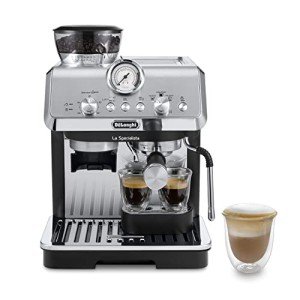10 Things We Hate About Home Use Espresso Machines

Home Use Espresso Machines: A Comprehensive Guide
Espresso machines have ended up being a staple in many homes as coffee lovers look for to reproduce café-quality brews in the convenience of their kitchens. The increase in appeal has caused a varied market filled with numerous models, features, and rates. This article intends to supply a useful overview of home use espresso machines, helping readers browse their alternatives efficiently.
Understanding Espresso Machines
Espresso machines work by requiring hot water through finely-ground coffee under high pressure, resulting in a concentrated coffee drink called espresso. There are numerous types of espresso machines classified based upon their brewing approaches and level of automation. The most typical types include:
- Manual Espresso Machines: These require the user to control the pressure and water flow, allowing for a more hands-on coffee-making experience.
- Semi-Automatic Espresso Machines: These provide automatic control over water pressure, while the user manually grinds and tamps the coffee.
- Automatic Espresso Machines: With the push of a button, these machines automatically manage the flow of water, making it easier to brew espresso with constant outcomes.
- Super-Automatic Espresso Machines: These all-in-one machines handle grinding, tampering, brewing, and even milk frothing, making them ideal for users looking for benefit.
- Pill or Pod Machines: These use pre-packaged coffee pods to create espresso with very little effort, but they limit option in developing techniques and flavors.
Table: Comparison of Espresso Machine Types
| Type | Control Level | Alleviate of Use | Cleaning up Level | Suitable For |
|---|---|---|---|---|
| Manual | User-controlled | Moderate | High | Coffee purists |
| Semi-Automatic | Partial automation | Moderate | Moderate | Home baristas |
| Automatic | Completely automated | Easy | Low | Hectic people |
| Super-Automatic | Totally automated | Extremely simple | Extremely low | Convenience candidates |
| Capsule/Pod | Fully automated | Really simple | Extremely low | Casual drinkers |
Secret Features to Consider
When choosing a home use espresso machine, it's vital to consider numerous features that can significantly affect the quality of espresso and user experience.
- Pressure: Look for machines that offer at least 9 bars of pressure, as this is thought about optimum for developing espresso.
- Boiler Systems: Single vs. dual boiler systems determine temperature level stability and the capability to brew espresso and steam milk simultaneously.
- Grinder: Integrated mills enable freshly ground coffee, which boosts flavor. Consider machines with adjustable grind settings.
- Milk Frother: For those who take pleasure in coffees and lattes, an integrated steam wand or automatic frother is important.
- Size and Design: Consider your kitchen area and aesthetic preferences. Machines are available in different sizes, from compact to large setups.
- Cost: Home espresso machines can range from a couple of hundred to several thousand dollars, so it's important to establish a budget before exploring options.
Benefits and drawbacks of Home Use Espresso Machines
| Pros | Cons |
|---|---|
| Convenience of developing coffee at home | Initial financial investment can be high |
| Quality of espresso is frequently remarkable | Needs some ability, particularly with manual machines |
| Ability to experiment with flavors | Upkeep and cleansing can be labor-intensive |
| Can save money in the long run | Not all machines will match every coffee choice |
Maintenance and Cleaning Tips
Keeping an espresso machine is essential for extending its life and guaranteeing consistent brew quality. Here are some useful suggestions:
- Regular Descaling: Minerals from water can construct up in the machine. Descale every 1-3 months, depending upon water solidity.
- Daily Cleaning: Rinse portafilters, baskets, and steam wands after each use to prevent coffee oils from building residue.
- Use Filtered Water: This can help in reducing mineral accumulation and improve the taste of coffee.
- Change Gaskets and Seals: These elements might wear over time and should be changed to keep pressure and performance.
- Check out the Manual: Each machine has specific care directions; following these will make sure durability.
FAQs About Home Use Espresso Machines
Q1: What is the very best budget espresso machine?The best budget espresso machine typically depends upon individual needs, but models like the DeLonghi EC155 or the Breville Bambino are popular among users for supplying fantastic value. Q2: How long do home espresso machines typically last?With correct upkeep, home espresso machines can last anywhere from 5 to 15 years, depending on the quality of the machine and frequency of use. Q3: Can I make coffees and lattes with any espresso machine?While most espresso machines can make cappuccinos and lattes, having a reliable
steam wand or frother is important for accomplishing the ideal milk texture.
Q4: Are super-automatic machines worth the investment?For those who prioritize convenience and fast developing, super-automatic machines can be worth the investment, though they might do not have some customizability in brew strength and flavor. Q5: What kinds of coffee beans are best for espresso?While Compact Espresso Machines plays a function, beans labeled as" espresso "blends are usually roasted darker, developing rich flavors and a velvety texture when brewed.
Investing in a home espresso machine can transform the everyday coffee regimen into something special, raising home brews to café quality. By understanding the various kinds of machines, key features to think about, upkeep requirements, and weighing the
advantages and disadvantages, consumers can make educated choices that fit their individual choices. As the espresso culture continues to grow, no matter the option, every brew can be a tasty experience waiting to be relished.

